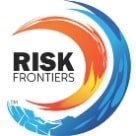November 2019: Sunshine Coast Hailstorm
On the afternoon of November 17th, 2019, the Bureau of Meteorology (BoM) issued a warning that Queensland would experience severe wind and giant hail. Multiple news sources reported cricket-ball sized hail in the greater Sunshine Coast region. Accompanying videos and images from social media, both during and after the event, often depicted the damage wrought by the deluge, with shattered car windscreens being a common sight. The Insurance Council of Australia (ICA) declared the Sunshine Coast storm a catastrophe two days later. The majority of claims lodged thus far have been for motor vehicle. The current estimated loss value is $115M as reported by the ICA. For comparison, the current bushfires (declared a catastrophe from November 8th) have an estimated loss of $165M.
Risk Frontiers implemented the same approach for this storm as for the December 20th, 2018 Sydney hail catastrophe[1]. To determine storm footprints and estimate damage extents, the Maximum Estimated Size of Hail (MESH) algorithm ((originally due to Witt et al. (1998) )[2] was applied to radar volumes from the Australian Open Radar Dataset (AORD). The Marburg and Mt. Stapylton radars near Brisbane were chosen, over the time period from 10:00AM to 4:00PM AEST. Location of radars and the MESH results are shown in Figure 1. Image processing is applied to the cumulative MESH grid over the time period to extract the boundaries of the storm (using a threshold of 20mm, the criterion for a severe hail event in the BoM Severe Storms Archive). An ellipse is fit to that contour to compare against HailAUS, our detailed catastrophe loss model for hail, in order to estimate losses for the event.


Using the 20mm threshold ellipse fit and a range of hail sizes around the absolute maximum size detected of 7.7cm gives estimated damages of $150M +/- $40M using the HailAUS7.1 damage module against the PERILS 2018 Hail Industry Exposure Database. It is worth noting that the apparent storm footprint obtained from radar may not be equivalent to the ultimate damage footprint. The hail trajectories as they fall from the stormcell will be influenced by ambient wind. There is also a discrepancy in the location of max hail size relative to the ellipse centroid (the ellipse is fitted to an outer contour, but the 3D shape of that geometry is asymmetric along the ellipse axis).
Following the above event, on November 26th, the North Shore and Northern Beaches of Sydney experienced severe winds and pea-sized hail over a relatively short time window. The hail from this event is not expected to have generated much damage given the size. However, fallen trees from the wind disrupted transport and damaged structures and vehicles. The event caused multiple power outages in those areas, affecting 52,000 addresses at the peak of the storm with 13,000 addresses still without power 4 days later. The loss from this single event would be relatively small, but similar events could accrue substantial costs over the course of one season (hail is most frequent in the summer months).
[1] Risk Frontiers, March 2019 Newsletter
[2] An Enhanced Hail Detection Algorithm for the WSR-88D, Witt et al, 1998
About the author/s

Salomé Hussein
Salomé is our expert in machine vision, radar analysis, and robotic process automation (RPA). She holds a PhD in Physics and specialises in modelling hail and agriculture.

Jacob Evans
Jacob has been involved in the development of our FloodAUS, CyclAUS and QuakeAUS Cat-Loss models. He specialises in data science and mathematics.
Jacob received his PhD in Condensed Matter Physics from Macquarie University. Jacob’s interests include data science, numerical modelling, physics and mathematics.
Joining Risk Frontiers in 2017, Jacob has worked across a range of projects from model development and climate risk management to resilience and portfolio modelling.
Notably, Jacob has employed techniques such as machine learning and statistical analysis to understand the vulnerability of risk across Risk Frontiers catastrophe suite, as well as applying machine learning algorithms for flood, cyclone and earthquake models. He also works on hazard and loss modelling.
